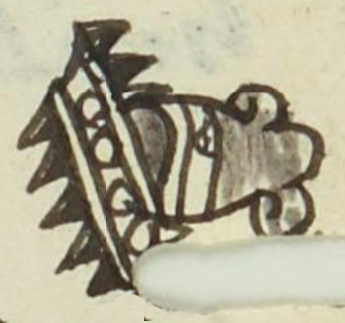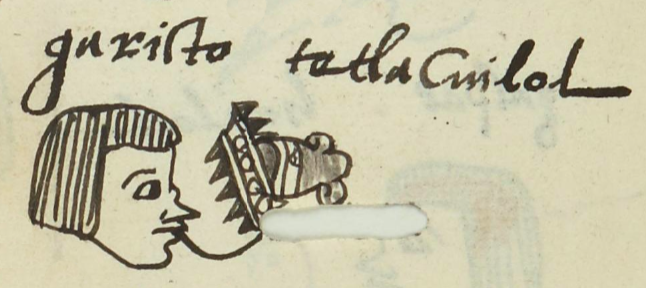Tetlacuilol (MH522v)
This black-line drawing of the compound glyph for the personal name Tetlacuilol ("A Carved Stone" or “A Design in Stone,” attested here as held by a man) shows a horizontal stone (tetl) with one end covered up and one end showing the usual curls. The stone is dark gray with white stripes. Obscuring the left end of the stone is a diagonal object with obsidian points on both sides, black and white stripes down the middle, and in the middle of the stripes there are white circles. This object may represent the importance of design (tlacuilolli) in the carving of stone, although an obsidian tool may have been used to carve the stone.
Stephanie Wood
The pointed diagonal piece is very much like the glyph for the names Itzcoatl and Itzcoa, "Obsidian Blade-Serpent." It is unclear at this point why the glyph for a design carved in stone would be pointing to Itzcoatl; perhaps the person with this skill worked with obsidian points.
Marc Thouvenot identifies the verb icuiloa (or ihcuiloa, with the glottal stop), which means to paint, write, or print, as having a root of -cuil-. He notes how it also appears in tlacuiloliztli (writing), tlacuilo (writer), and cuicuiltic (mottled). He goes on to show various uses of icuiloa that take it beyond the simple definitions just given, resulting in something like the action of creating a design (e.g., on leather, ceramics, sculpture, or in textiles). It can also be something like the action of decorating (e.g., to put a flower on a cup of atole). He associates icuiloa and tlacuilolli with "cultural artifacts," such as arts and crafts or examples of writing and painting, but cuicuiltic with effects created by "nature." This short summary barely does his article justice; it is worth reading the entire piece. How Thouvenot's study might connect with the concept of bent or curved mentioned by Prem (1974: 555, 682) raises an interesting question. Perhaps the bent or curved lines of writing, painting, carving, embroidery, and so on, fall with in the realm of expressions of -cuil-. See
Marc Thouvenot, "Imágenes y escritura entre los nahuas del inicio del XVI," Estudios de Cultural Náhuatl 41 (2010).
Stephanie Wood
garisto tetlacuilol
Calixto Tetlacuilol
Stephanie Wood
1560
José Aguayo-Barragán
stones, piedras, designs, diseños, sculpt, esculpir, carve, tallar

te(tl), stone, https://nahuatl.wired-humanities.org/content/tetl-
tlacuilol(li), document, painting, design, https://nahuatl.wired-humanities.org/content/tlacuilolli
Diseño en Piedra
Stephanie Wood
Matrícula de Huexotzinco, folio 522v, World Digital Library. https://www.loc.gov/resource/gdcwdl.wdl_15282/?sp=183&st=image
This manuscript is hosted by the Library of Congress and the World Digital Library; used here with the Creative Commons, “Attribution-NonCommercial-ShareAlike 3.0 License” (CC-BY-NC-SAq 3.0).







